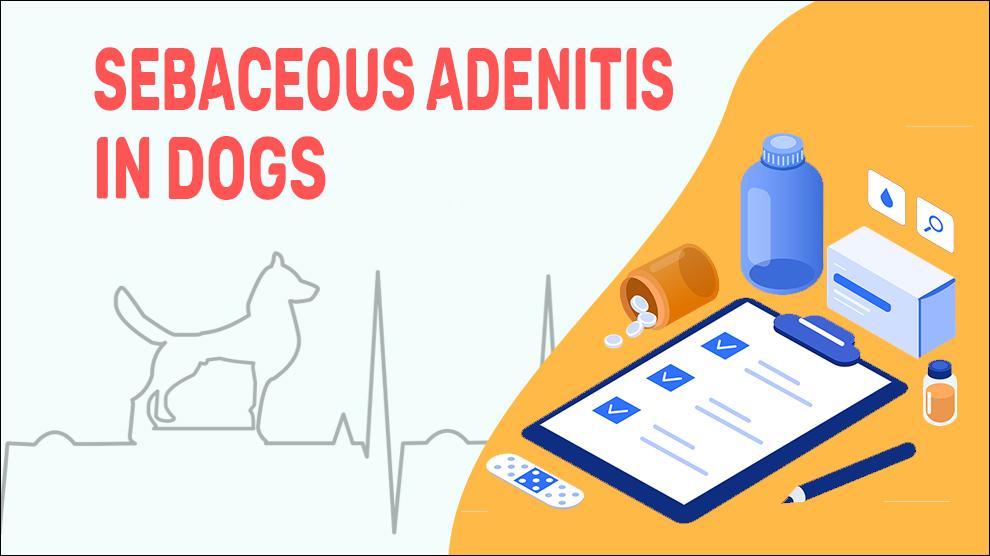What Is Sebaceous Adenitis In Dogs?
Sebaceous adenitis (SA) is a rare, immune-mediated, inflammatory dermatosis that happens in the sebaceous glands in the skin of dogs. This causes crusting, nonpruritic, and cornification irregularity that can lead to compactly adherent crusts and scales with progressing alopecia.
The etiology is poorly understood, but it is an inflammatory, primary follicular keratinization defect in the sebaceous glands and ducts, as the ability to regrowth of hair follicles is affected. SA often manifests with a considerable change in the coat texture, quality, and the pet’s exterior. The hair coat in affected areas often changes both in color and consistency after being damaged in the process (e.g., dull, dry, or matted or apricot to dark brown).
Scaling will be average to severe and mostly involves the top of the head, dorsum of the neck, dorsal nasal planum, ears (external canals or pinnae), tail, and back. The conditions of skin may be generalized over the trunk or become multifocal or remain localized.
In short-haired dogs, areas may expand and ultimately cause diffuse alopecia or coalesce into serpiginous patterns. The scales are generally non-adherent and fine. In longer-haired dogs, there will be tightly adherent silver-white scales to the hairs, non-pruritic symmetrical or patchy alopecia and the fur may be dry, dull, or tangled; follicular casts and secondary bacterial folliculitis are common. The undercoat is severely damaged whereas the outer hairs are spared usually.
While this disorder is usually cosmetic and doesn’t have much impact on a dog’s health, it can make the skin highly susceptible to secondary yeast and/or bacterial infections.
Symptoms Of Sebaceous Adenitis In Dogs
Long Haired Breeds
- Alopecia (Hair loss)
- Scaling and flaking of the skin
- Silver-white scales on the skin
- Coat changes (coarser, dull, and brittle)
- A musty odor, especially along the hairline
- Small tufts of matted hair
- Pruritus (primarily with bacterial or yeast infection)
- Hot spots
- Sores and scabs
Short Haired Breeds
- Mild scaling along the head, ear flaps, and torso
- Scales non-adherent to hair
- Hair loss (Annular to patchy)
- Bacterial infection is rare
Treatment Options For Sebaceous Adenitis In Dogs
There is no proper treatment for sebaceous adenitis.
Topical treatments: Keratolytic shampoos and humectants or emollient rinses.
Oil baths or oil sprays: Baby oil, Avon Skin-So-Soft, or Alpha-Keri oil (mineral oil mix).
PROPYLENE GLYCOL 70%: Can be used topically once in 3 days for 3 weeks. After that, it can be used weekly once.
Secondary skin infections are treated by Antibiotics and Antifungal Medications.
Corticosteroids and Immunosuppressive Agents: Cyclosporine (Atopica) and Cortisone (dexamethasone, prednisone, prednisolone).
Home Remedies For Sebaceous Adenitis In Dogs
- Discuss with the veterinarian dermatologist for any home care specific to your dog’s situation.
- Vitamin A, Vitamin C, Vitamin E, Oral omega-3, and/or omega-6 essential fatty acids may be recommended.
- Medicated shampoos, Moisturizing rinses and sprays, antibacterial wipes, and topical treatments can be prescribed.
- Other Supportive therapies include Topical lipid skin treatments and oral antihistamines.
How To Prevent Sebaceous Adenitis In Dogs?
Sebaceous adenitis pathogenesis is poorly understood. The etiology is not yet known. The skin condition is inherited in many breeds so it is better to assess the affected dogs before breeding or at least before obtaining a dog from an unknown lineage, it is better to screen the dogs for skin irregularities.
Affected Dog Breeds Of Sebaceous Adenitis
Causes And Prognosis For Sebaceous Adenitis In Dogs
1. Causes:
Hereditary: An autosomal recessive mode of inheritance with a variable expression has been identified in many breeds.
2. Mortality:
There is no mortality documented because of sebaceous adenitis.
3. Diagnosis:
- Routine hematology
- Blood and urine tests
- Surgical biopsy
- histopathological examination of the skin
- Intradermal or blood allergy testing.
4. Prognosis:
The prognosis for sebaceous adenitis is guarded to poor. There are many conditions that can lead to scaling and hair loss in dogs. Different diagnostic tests have to be performed by vets to exclude several diseases that present with similar symptoms, such as parasitic infections or allergies. Hyperadrenocorticism, hypothyroidism, or bacterial/Fungal infections are tested by performing skin biopsies.
When To See A Vet For Sebaceous Adenitis In Dogs?
- Alopecia (Hair loss)
- Scaling and flaking of the skin
- Silver-white scales on the skin
- Coat changes (coarser, dull, and brittle)
Food Suggestions For Sebaceous Adenitis In Dogs
- Consider a diet with all essential nutrients and also provides plenty of antioxidants (combat free radicals)
- A wholesome food, minimally-processed, that is free of preservatives and chemicals
- Avoid foods with toxic additives. Keep away from butylated hydroxyanisole (BHA) and ethoxyquin
- An allergen-free (hypoallergenic) balanced diet (check for thickeners, coatings, flavors)
- Try an elimination diet after food sensitivity testing. Many prescribed medications for an autoimmune disease can cause GI and non-GI woes
- Consider probiotic foods and/or supplements
Conclusion
Though the sebaceous adenitis hair loss of affected dogs will be irreversible, the resultant skin issues recovery is good with proper treatment. Discuss with the veterinarian before using any Topical applications, antibacterial conditioning sprays, medicated baths, and skin wipes.

















